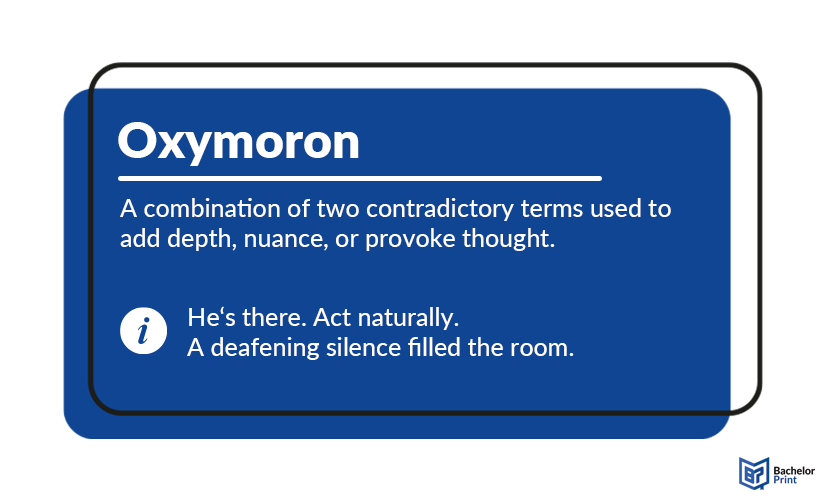
In academic writing, the term “oxymoron” is a rhetorical device and refers to a construct of two contradictory words, creating a paradoxical effect. This rhetorical device is integral in enhancing and emphasizing meanings by combining elements that conventionally negate each other. Analyzing these literary devices in academia contributes to exploring the collective human experience, paradoxes in concepts, and overall dynamics of the English language.
Definition: Oxymoron
An oxymoron (pl. oxymorons or oxymora) is a figure of speech composed of two contradictory words or terms to express a paradoxical meaning. Essentially, they are phrases that juxtapose two words that are traditionally incompatible or have opposing meanings. This can help to add depth and convey a stronger message, often by underscoring the irony or complexity of a situation.

Etymology
Tracing back to Ancient Greece, the meaning of oxymoron can be understood from its compilation of the two Greek words:
- “oxys” – translating to “keen” and “sharp.”
- “moros” – translating to “foolish”
In combination, the direct translation of it is “keenly stupid” or “sharp-foolishness,” expressing the rhetorical device’s peculiar paradox and contradiction. In the early 17th century, this term was adopted into the English language, encapsulating the essence of combining opposing ideas for a paradoxically insightful effect and illustrating that traditionally contradictory terms can coexist within a single phrase.
Examples
Although the two terms in oxymorons conventionally oppose each other, in combination, they are fascinating constructs, creating meaningful and powerful expressions. Some of the most popular ones are outlined below.
All examples contain two terms that are inherently incompatible and embody each other’s opposite. They showcase that oxymorons effectively capture the multifaceted nature and complexity of a range of concepts.
For more examples, you can check out our downloadable sheet below. On the left you find a list with numerous examples and on the right you find a list with more detailed examples including example sentences and an explanation of the meaning of the oxymoron.
Use and origin
The use of oxymorons can be traced back through an array of historical periods. They can be found ranging from classical literature, mostly used by philosophers and poets, expressing contradiction in terms, to contemporary and modern everyday speech, where they serve as figures of speech and add nuance and depth.
In classical literature, renowned poet and celebrated playwright William Shakespeare masterfully used oxymorons to communicate the complexity and multifaceted nature of conflicts, human emotions, and other paradoxical themes within his works. Here are a few notable examples:
In modern literature, William F. Buckley Jr., a renowned American conservative author and founder of the “National Review” magazine, left a mark due to his eloquent speaking style and extensive vocabulary. He often included rhetorical devices and figures of speech, specifically oxymorons, to underscore critique opponents, points, or outline the complexities of social and political issues. The author is famous for quotes like, “An intelligent liberal is an oxymoron,” referring to his political stances.
William Buckley’s talent for writing and debating allowed him to delve into the ideologies of politics, frequently highlighting the contrast between policies and philosophies. Buckley’s televised discussions and debates on “Firing Line” are rich in oxymoron examples to articulate conservative viewpoints, arguments, and overall engagement in topics. Moreover, many oxymoron expressions can be picked up on in his books, such as “The Unmaking of a Mayor,” “God and Man at Yale,” and a range of columns published in “National Review.”
Types
Based on their nature, complexity, and application, oxymorons can be organized into various categories. They have been present in the English language since the Ancient Greek era, yet there often occur difficulties in identifying them. The following will account for the commonly identified types of oxymorons in everyday language and literature.
This type of oxymoron is typically used in a humorous context, like amusing or comical expressions. They often point out the absurdity or irony of combining contradictory words. The following illustrates examples of common comical oxymorons.
The absurdity of this expression is that an effort has to be made to appear natural, although conventionally, the nature of someone comes as a matter of course without any extra effort. Typically, it takes on the meaning that someone must behave in a way that other people do not grasp what is actually going on.
This is a playful expression of someone in a confused state that is, however, clear to others.
As the name already tells, this type often involves a more complex, sophisticated, or nuanced contrast. They often refer to emotional states or concepts, so that reading between the lines to understand the full meaning often requires more contemplation. Below are two examples to provide a better insight.
This oxymoron encapsulates the feeling that something can be emotionally moving or aesthetically pleasing to the extent that it causes a sense of longing or pain. This may be due to the realization that beauty is passing or temporary, the overwhelming emotions that are evoked by the beauty, or the inability to possess the beauty.
Communicating a secret or a rumor in a whisper between several people adds intensity and creates a deafening effect, as it spreads across and influences actions and opinions of others disproportionately to its quiet beginnings.
This type of oxymoron entails oppositions and contrasts between concepts and ideas rather than simple words. Similar to complex oxymorons, they require a certain level of reflection and abstraction to be fully understood, as they revolve around conflicting ideologies and principles. Here are two examples.
In this context, the oxymoron refers to the natural ecosystem in the rainforest. From the outside and with little knowledge, the rainforest seems like a massive and chaotic structure consisting of countless species of animals and plants. However, the ecological balances and cycles portray a sophisticated order that organizes the energy flow and life in the forest.
This oxymoron can be applied in discussions revolving around social reforms in politics. Although there may be a lot of debating and discussion about a topic, representing the movement, the issues being addressed or fundamental conditions barely change. Thus, the “movement” juxtaposes with the “static.”
This type often reflects on historical events that have been impactful, or contradicts situations that have occurred in the past. Get a better insight with the examples below.
Mahatma Gandhi emphasized non-violent resistance during the Indian Independence Movement, which ultimately resulted in India gaining independence from the British in 1947. This historical event represents a peaceful revolution, as the approach was non-violent, but ultimately caused a revolution that inherently has a disruptive and violent connotation to it.
This historical oxymoron is also a widely used term in historical context, referring to a conflict that occurs within a country or nation. In other words, it describes a war between citizens in the same country, which contradicts the principle of civil harmony. In this example, the American Civil War describes the war between the Northern and Southern states of the USA.
Oxymorons with a literal meaning contain a direct contradiction that does not require a deeper level of contemplation. The following examples provide a better understanding.
Here, the concept of something being “open” literally illustrates that something is accessible. On the contrary, “secret” indicates something that is concealed. In this example, the company’s impending merger is information that is known but not openly acknowledged.
The word “liquid” refers to a substance that has a definite volume but no fixed shape, whereas “gas” has neither a definite volume nor shape. In this example and in a literal sense, it refers to a substance that acts as both.
In the figurative language, they contain contradictions in concepts, emotions, or ideas. They often have a metaphorical connotation to visualize feelings, emotions, or concepts. Here are a few examples.
This expression contrasts the taste “bitter” with “sweet.” Combined in a figurative sense, it describes the sadness of saying goodbye, yet the joyful celebration of the friendship.
The living dead typically describes an individual who is physically alive but lacks purpose, genuine life experience, or vitality. Often, it is a person who seems to be on autopilot and has no drive or true passion. Other terms describing this state are “zombie-like” or “emotionally disconnected.”
In a simple sense, their contradictions are apparent in the words and the meaning is straightforward. Typically, they entail contradictory terms that create a clear contrast. The following examples illustrate simple oxymorons.
In a culinary context, “jumbo shrimp” is a term for large-sized shrimps or prawns. They have an oxymoron nature, as “jumbo” refers to something being large in size, which contrasts with “shrimp,” as they are overall small in size. This term factually describes “jumbo shrimps” and is primarily used for this culinary dish, making it a to-the-point and simple oxymoron.
This term mainly refers to a specific type of damage that occurs when food that is stored in the freezer is exposed to cold and dry air, causing it to dehydrate and deteriorate. In itself, it represents an oxymoron at the same time, which is clearly apparent as the two words oppose each other in meaning. “Freezer” refers to the device that is used to keep food preserved and cold, while “burn” describes damage usually caused by fire or heat.
These types are often intriguing, as they illustrate and visualize elements in combination that are traditionally considered incompatible or opposite. Perceiving them visually often creates a thought-provoking and striking contrast. The following outlines two examples of visual oxymorons.
The concept of “icy fire” can be interpreted in several ways. The example refers to a complex emotion that combines elements of detachment or coldness with intense desire or passion. Essentially, it illustrates that contrasting feelings towards someone or something can coexist.

The concept of “dark light” has an array of interpretations in various contexts. It often embodies the juxtaposition of enlightenment and obscurity, clarity and mystery, and presence and absence. The example expresses the acknowledgment that unsettling or forbidden knowledge may be insightful and enlightening, but also casts shadows on one’s morality or worldview.

When two contradictory words are combined to create a new paradoxical meaning, expressing nuanced or complex viewpoints, we speak of an opinion oxymoron. Their purpose is to reflect the irony, multifaceted nature, or ambivalence of the speaker’s opinion. Certain opinion oxymorons are widely debated, whether they can be categorized as oxymorons, as they have been created based on personal opinions and stances. The following examples give a more profound insight into these opinion-based contradictions.
This expression is often used in situations that entail “tough love.” It typically describes a situation, where an action has kind intentions and a long-term beneficial effect, but has a harsh or cruel execution at the moment. In other words, strict measures may be taken to teach resilience or responsibility or cruel kindness will result in long-term benefits.
In this case, “benevolently manipulative” refers to manipulative actions carried out with good intentions. This is often used in situations, where purposefully imposed manipulative behavior is done to, ultimately, reach a beneficial outcome for the manipulated person. The novelist believes that the end justifies the means, making his actions opinion-based.
Oxymoron vs. antonym pairs
Oxymorons and antonym pairs are both categorized as literary devices and consist of contrasting relationships between words. However, they have slight differences in terms of their purpose and use. An extensive understanding of the distinction is vital and enriches one’s ability to appreciate the nuances and depth of language, and helps analyze and comprehend communication.
The fundamental differences between these literary devices are showcased in the following table, underscoring how each is used in language for specific purposes and effects.
| Oxymorons | Antonym Pairs | |
| Definition | A figure of speech that combines contradictory terms in close conjunction to create a paradoxical effect. | Two words with opposite meanings, used to describe the different ends of a spectrum or completely divergent concepts. |
| Purpose |
|
|
| Construction | A combination of two seemingly contradictory words to form a new, paradoxical concept with a specific meaning. | A combination of two opposing words used separately, without creating a new concept when mentioned together. |
| Effect | Highlights complexity and depth, often with a poetic or dramatic impact. | Emphasizes the difference between concepts, used for clarity and comparison. |
| Examples |
|
|
The key differences between them are found in their purpose, construction, and effect.
- Purpose: Oxymorons have the purpose of discovering the layers of ideas that involve both terms, indicating a deeper reality. Antonym pairs draw a clear distinction or boundary between concepts.
- Construction: Oxymorons shape new paradoxical concepts by deliberately combining contradictory terms. Antonym pairs include two opposing words used separately without forming a new meaning in combination.
- Effect: Oxymorons often have a metaphorical nature, creating a dramatic or poetic effect. Antonym pairs are direct and clear comparisons, highlighting the difference between two concepts.
Printing Your Thesis With BachelorPrint
- High-quality bindings with customizable embossing
- 3D live preview to check your work before ordering
- Free express delivery
Configure your binding now!
FAQs
Oxymorons are figures of speech that combine two words that have contradictory or opposite meanings, creating a rhetorical effect and new paradoxical concepts.
Some of the most commonly known are:
- Old news
- Pretty ugly
- Awfully good
- Seriously funny
- Only choice
- Definite maybe
Yes. Although the two combined words “bitter” and “sweet” are written together, this term also represents an oxymoron. In the article, you can find a thorough breakdown of this word.
Oxymorons and paradoxes are often associated with each other, as they have similar constructs. Paradoxes also involve contradictions, while they are both rhetorical devices with self-contradictory elements, paradoxes can actually be true, whereas oxymorons often have a more metaphorical sense.
A paradox has a self-contradictory nature and opposes common sense, yet often has a certain truth to it.
